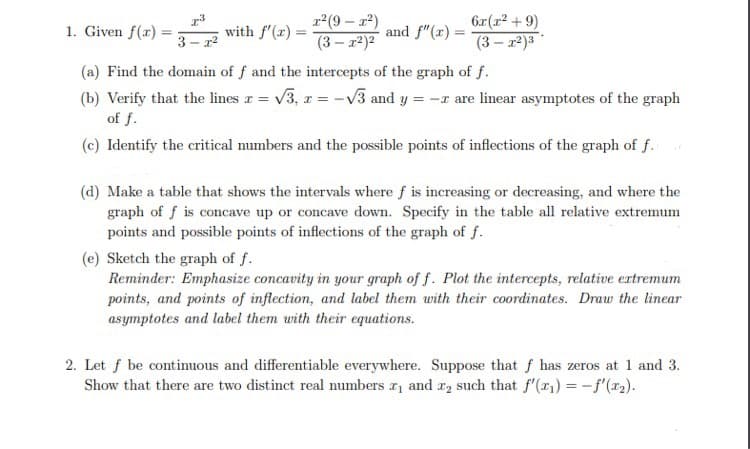Find the domain of f and the intercepts of the graph of f.
Advanced Engineering Mathematics
10th Edition
ISBN:9780470458365
Author:Erwin Kreyszig
Publisher:Erwin Kreyszig
Chapter2: Second-order Linear Odes
Section: Chapter Questions
Problem 1RQ
Related questions
Question
number 2

Transcribed Image Text:r(9 – x2)
(3 – 2)2
6x (r2 + 9)
1. Given f(r) =
with f'(x) =
and f"(x) =
3 - 12
(3 – 12)3
(a) Find the domain of f and the intercepts of the graph of f.
(b) Verify that the lines r = v3, z = -v3 and y = -r are linear asymptotes of the graph
of f.
(c) Identify the critical numbers and the possible points of inflections of the graph of f.
(d) Make a table that shows the intervals where f is increasing or decreasing, and where the
graph of f is concave up or concave down. Specify in the table all relative extremum
points and possible points of inflections of the graph of f.
(e) Sketch the graph of f.
Reminder: Emphasize concavity in your graph of f. Plot the intercepts, relative extremum
points, and points of inflection, and label them with their coordinates. Draw the linear
asymptotes and label them with their equations.
2. Let f be continuous and differentiable everywhere. Suppose that f has zeros at 1 and 3.
Show that there are two distinct real numbers r and r2 such that f'(r1) = -f'(x2).
Expert Solution
This question has been solved!
Explore an expertly crafted, step-by-step solution for a thorough understanding of key concepts.
Step by step
Solved in 4 steps with 4 images

Recommended textbooks for you

Advanced Engineering Mathematics
Advanced Math
ISBN:
9780470458365
Author:
Erwin Kreyszig
Publisher:
Wiley, John & Sons, Incorporated

Numerical Methods for Engineers
Advanced Math
ISBN:
9780073397924
Author:
Steven C. Chapra Dr., Raymond P. Canale
Publisher:
McGraw-Hill Education

Introductory Mathematics for Engineering Applicat…
Advanced Math
ISBN:
9781118141809
Author:
Nathan Klingbeil
Publisher:
WILEY

Advanced Engineering Mathematics
Advanced Math
ISBN:
9780470458365
Author:
Erwin Kreyszig
Publisher:
Wiley, John & Sons, Incorporated

Numerical Methods for Engineers
Advanced Math
ISBN:
9780073397924
Author:
Steven C. Chapra Dr., Raymond P. Canale
Publisher:
McGraw-Hill Education

Introductory Mathematics for Engineering Applicat…
Advanced Math
ISBN:
9781118141809
Author:
Nathan Klingbeil
Publisher:
WILEY

Mathematics For Machine Technology
Advanced Math
ISBN:
9781337798310
Author:
Peterson, John.
Publisher:
Cengage Learning,

